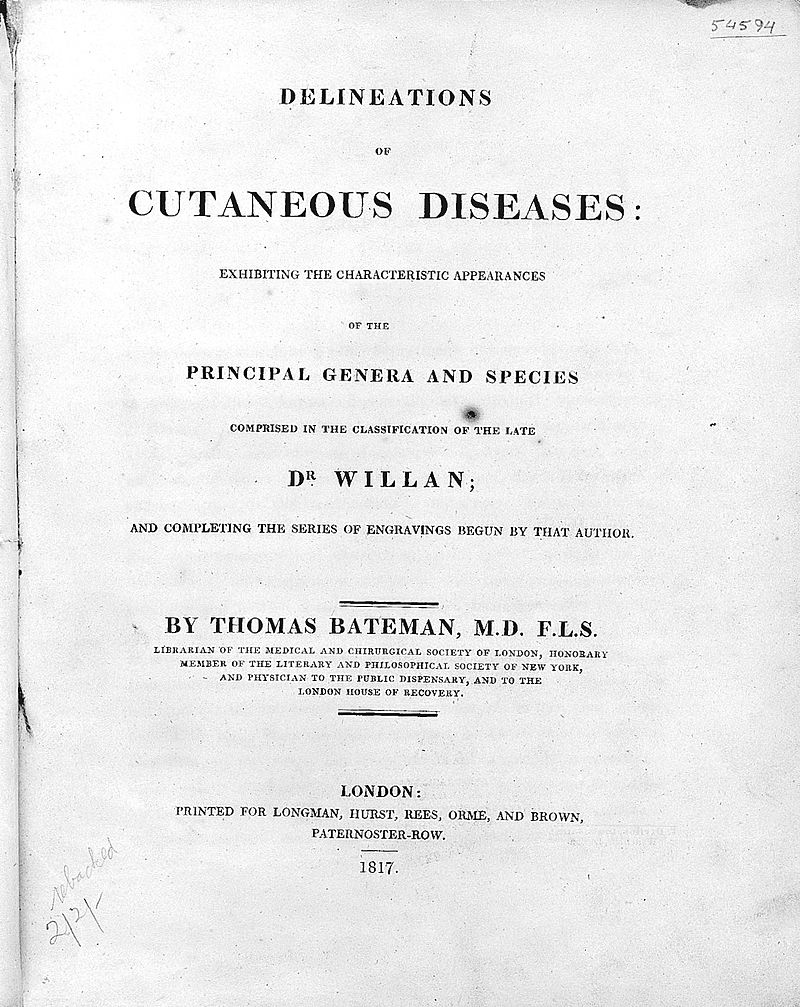<Back to Index>
- Physician Thomas Bateman, 1778
- Dermatologist Laurent - Théodore Biett, 1781
PAGE SPONSOR

Thomas Bateman (29 April 1778 – 9 April 1821) was a British physician and a pioneer in the field of dermatology who was a native of Whitby, Yorkshire.
He earned his medical degree from the Edinburgh Royal Infirmary School of Medicine. Bateman was a student, colleague and successor to Robert Willan (1757 – 1812) in regards to modern dermatological practices of classification.
Prior to the 19th century, classification of skin diseases were based on symptomatic characteristics. Dr. Willan was the first to propose a rational naming standard based on the appearance of the skin disorder. In the treatise On Cutaneous Diseases, Willan was the first to classify skin diseases from an anatomical point of view. However, Willan died in 1812, leaving Bateman to continue and expand on the work of his mentor. In 1813 Bateman published A Practical Synopsis of Cutaneous Diseases According to the Arrangement of Dr Willan, and in 1817 published an atlas called the Delineations of Cutaneous Disease. Today there is a copy of the atlas in the library of the Royal College of Physicians in London.
Bateman is credited for providing names and descriptions
for a number of dermatological diseases, including lichen
urticatus, alopecia areata, erythema multiforme and
molluscum contagiosum. The work of Willan and Bateman
influenced many physicians, such as Thomas Addison (1793 –
1860), who was a pupil of Bateman, and Laurent - Théodore
Biett (1781 – 1840), who introduced their methodology into
French medicine.
Laurent - Théodore Biett (July 25, 1781 – March 3, 1840) was a Swiss born dermatologist from Schams in the canton of Graubünden. He is chiefly remembered for introducing into France an anatomical methodology of analyzing skin diseases; a system that was first developed by British dermatologist Robert Willan (1757 – 1812).
In 1786 he moved with his family to Clermont - Ferrand. He received his initial medical education at the Hotel - Dieu in Clermont - Ferrand, relocating to Paris in 1801, where he became a favorite student of Jean - Louis Alibert. When Alibert's work at the Hôpital Saint - Louis was interrupted by royal obligations, Biett filled in for his teacher. From 1813 Biett was a doctor of medicine, later becoming chief medical officer at Hôpital Saint - Louis.
Biett was not known for his published works, however two of his students, Pierre Louis Alphée Cazenave and Henri Édouard Schedel, took assiduous notes of his lectures. In 1828 Cazenave and Schedel published Abregé pratique des maladies de la peau, which was a compilation of Biett's teachings and was to became a major work in dermatology. Cazenave is credited for coining the term "lupus erythemateaux" (lupus erythematosus), derived from Biett's symptomatic descriptions of the disease.
Biett was a member of the Académie royale de Médecine, and in 1830 was awarded with the Légion d'honneur.
- Biett's collarette: a syphilitic symptom in which the center papule is encircled by a ring of scales.